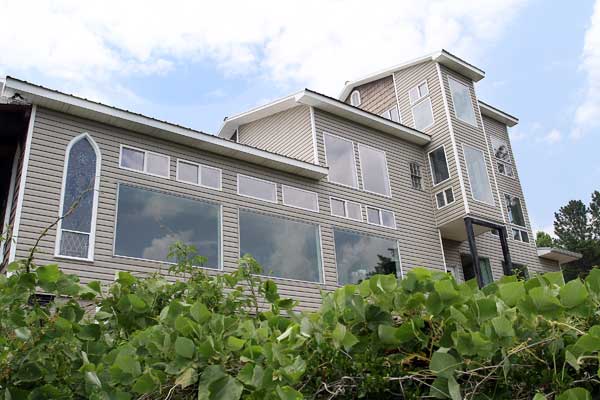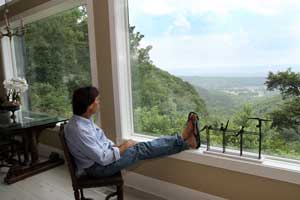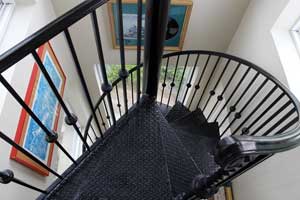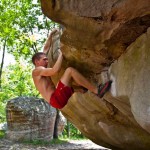

By David Story
Photos by Jerry Martin
Northeast of Birmingham, on the precipice of Chandler Mountain near Steele, sits an American classic: a rustic family home perched on the edge of a cliff like something out of a Hitchcock film.
The driveway to Chandler Falls Farm crosses a branch eerily named for a man better known for mayhem than family. There is a sign reading “Manson Branch” that according to homeowner John Ard, a surgical nurse at UAB, was a $3 thrift store find.
After crossing Manson Branch onto Chandler Falls Farm, visitors feel immediate relief at the sight of a bronze Foo dog on the porch of Ard’s family home and the hand-hewn logs flanking the front entrance and continuing into the interior living space.
Ard, who’s also known for officiating at tennis tournaments, says the logs were dismantled from a cabin in Andalusia, the front door’s an interior cathedral door from England, and the exterior lanterns are reproductions.
Ard directs visitors’ attention to the porch’s resident gargoyle, which was salvaged from a long-gone Brooklyn brownstone. Railings were custom-designed. No detail’s too small to overlook. At the house’s foundation are ornate vents found at an area estate sale.
Ard is almost apologetic in saying, “I wanted to do an all-brick exterior but went with cedar-shake vinyl siding.” But, he’s obviously proud of the porch’s support beams, the largest of which weighs 100 pounds, is a non-laminated beam cut in Louisiana and brought to Chandler Mountain.
The living room floors are from the same cabin from which the wallboards were reclaimed. Two leather armchairs and a matching dark-green love seat and sofa give off a masculine vibe. The rustic base of a glass-topped coffee table is an antique Alaskan sled, and flanking the flat-screen TV are two sets of stacked cabinets. Large-scale accessories include a taxidermist’s stuffed raptor and fox.
Ard explains the alcove between the cabinets: “I had to cut some corners as the budget excluded some things, such as a stacked-rock fireplace, although we poured the foundation so a fireplace can be easily added later.”
The large framed photograph over the sofa is Mad Ludwig’s Neuschwanstein Castle in Bavaria, and French sculptor Pierre-Jules Mene, born in Paris in 1810, was the originator of the sofa table’s reproduction bronze of a hunt scene.
Directionally contrasting rafters make for the transition from the living area to the kitchen, which is overseen by a large-scale angel carving. The custom-made kitchen countertops are Mozambique or “White Diamonds,” and the wooden hood above the stove is supported by ornate corbels.

A likewise angelic image of Julia Roberts, signed by the actress, is placed strategically on the kitchen counter. The cabinetry includes a built-in hutch with leaded glass doors, and the sunroom — with adequate space for dining — flows off of the kitchen.
It goes without saying the magnificent view of Chandler Mountain is the focal point of the sunroom. Expansive three-sectioned insets of windows, each about 50 feet wide, create a spectacular 150-foot-wide view that is panoramic in scope.
“What I think about when it comes to the view,” says Ard, “is the fog between the ridges, reminiscent of the Smokey Mountains, as it comes up and floats past the house. I love the view on winter mornings and when it’s sunny the rest of year. The property was previously used like a state park and has that same quality. Actually, a boy scout troop was once found camping out here, thinking they were at a nearby state park.”
The light of which Ard speaks is exquisitely filtered through stained-glass windows, circa 1871, from one of New York’s long-gone Catholic churches, both of which were made in memory of William S. and Elizabeth E. Corbett. The windows, jarringly juxtaposed with an authentic Ruby Tuesday’s door (a flea market find), depict St. Anthony turning toward the sea and speaking to the fish, who for their part, raise up their bodies and perch, as it seems, on top of the water. According to the homily upon which the stained images were based, St. Anthony then blessed the fish, which returned to the sea. In keeping with the sunroom’s theological theme, there are a smattering of crucifixes about.
A kitschy coat rack, circa 1970s, sports a vintage West Point cadet’s jacket. A bobcat, perfectly preserved by an adept taxidermist, pops in one corner.
The sunroom’s vintage 1895 solid walnut library table was refitted with a glass top and serves as a dining table. Across from the table hangs a black and white photo, titled “Flatiron No. 3”, which brilliantly depicts the legendary triangular Flatiron building in New York City, or the Fuller Building, as it was originally called, which is located at 175 Fifth Avenue.
The ornate staircase was salvaged by Burgin Construction from Selma’s pre-Civil War Albert Hotel (a replica of the Doge’s Palace in Venice), which was torn down in 1969. The staircase was later acquired and sold to Ard by Fritz Whaley of The Garages in Birmingham.
As visitors exit the sunroom, their attention is drawn to a print by Mexican American rock guitarist Carlos Augusto Selva Santana encased in an alcove of three windowed glass walls. The Santana graphic leads the way to a spiral staircase, meandering upwards to the guest rooms above. The view through the glass windows from the spiral stairs is dizzying. “When you walk down, you feel as if you might go over the edge, a la Hitchcock’s Vertigo, ” says Ard.
 The second floor hallway leading to the guest rooms features a striking nude, painted by Agnes B. Taugner in 1952. “Agnes Taugner, who taught at Auburn,” says Ard, “is a sweet lady and was a neighbor in Auburn, where I grew up after we moved there in the 1960s for my mom to go to grad school. Agnes was part of a group of family friends who regularly gathered around our kitchen table to discuss art and drama.”
The second floor hallway leading to the guest rooms features a striking nude, painted by Agnes B. Taugner in 1952. “Agnes Taugner, who taught at Auburn,” says Ard, “is a sweet lady and was a neighbor in Auburn, where I grew up after we moved there in the 1960s for my mom to go to grad school. Agnes was part of a group of family friends who regularly gathered around our kitchen table to discuss art and drama.”
The smaller upstairs guest room features twin beds and is called “the grandchildren’s room” for its coziness and intimacy. There’s an antique Eastlake chair, circa 1910, and an unruly bobcat throw complete with feline fur. This overall monochromatic beige room’s accented with floral prints on the walls and floral spreads on the half beds. An antique white-washed French commode hides in the corner.
The guest bath is illuminated by a Pella transom-style window with a clerestory effect. Ard’s most treasured possession in this bath is a signed photo of Sting. A re-slivered antique mirror rests on top of an antique vanity refitted as a countertop for the sink. Gold-plated swan-shaped faucets and blue and white decorative, hand-painted tiles add bursts of sheen and color.
The most prominent of the second-floor guest rooms features another Taugner painting. In this larger room, an armoire from the 1930s proportionately offsets the mirrored double doors. Over the bed hangs the other Taugner from 1996, with its hues of red and blue, depicting the Mexican El Dia de los Muertos or the Day of the Dead, a festival honoring the remembrance of deceased loved ones.
The most private of the guest rooms is Ard’s older daughter’s room. “This white guest room has a canopy bed from Henredon,” he says. “Her desk is Toscana from the Philippines and is hand-carved mahogany. There are family photos throughout the bedroom, and the side panel door was salvaged from a college campus. It was actually shown on the cover of a student brochure at Columbus’ Mississippi University for Women, in Columbus, Miss., where my daughter Angie went one summer when she was a junior in high school to participate in a special program for secondary students.”
At the very top of the house is a loft, which doubles as billiard room and sleeping quarters for Ard’s youngest child, and is chock full of pop culture memorabilia. Music-related artifacts include signed poster-sized images of Motley Crue and Aerosmith.
In homage to Manson Branch, which borders the property, a likeness of Charles Manson can be found taking a time-out in the billiard room’s closet. Scattered about is more signed memorabilia from Rod Stewart, Dolly Patron, the Pointer Sisters, Whitney Houston and Bob Dylan, the bulk of which is numbered and comprised of Charlie Hall personal Arista record label collection.
As to the origins of the memorabilia, Ard says, “The provenance is through The Magic Platter, and the pieces were collected from the artists by one of the business’s partners. The collection’s a conversation piece and contributes to the ambience. People said I wouldn’t be able to use a collection of pop memorabilia, but it works, just as the state-of-the-art kitchen works juxtaposed with the vintage, log cabin-inspired living area.”
On a more traditional note, next to the pool table, which is the loft’s centerpiece, aptly hangs a hobnailed and faux leather-matted reproduction of Ron Henry O’Neil’s The Billiards.
Back downstairs, Ard’s penchant for unusual art pieces is reflected in the Donald Grant hand-signed and numbered limited-edition prints, Big Cats and Tigers, which hang against a sage-green wall over a grouping of two 1920s walnut and cane chairs.
A focal point is a piece by artist Iris Margagaliotti hanging over the fireplace, the surround of which is from the 1920s and original to an old Mountain Brook home. Next to the hearth resides a regal lioness. The wall treatments, which frame yet another stupendous view, and matching bed linens are in a pattern of bright plum and muted-green floral with a touch of beige. The carpet’s a white Berber.
The pediment over the bed came from an old wardrobe and, in a utilitarian sense, gracefully supports the bed hangings, and aesthetically, it perfectly crowns the mound of tapestry pillows on the bed.
Adjacent is the master bath, which immediately draws the eye to a stained-glass window over the tub. The most unexpected find is a signed photo of the 1960s pops group The Monkees. The bath’s theme is a cherub motif, as shown by the vanity’s pot metal or “monkey metal” candelabra, angelic sconces, and cherubic statuettes flanking the tub from windowsill to floor. Also of note is a crystal and stained bronzed chandelier hung from an authentic horsehair and plaster medallion, a detail which Ard is quick to point out.
“When you design a building, structure and function are the easy part, but the artistry lies in the details,” concludes Ard, citing an old German proverb often attributed to Mies van der Rohe. As it turned out, the cliffside house in Hitchcock’s North by Northwest was a Frank Lloyd Wright-inspired Hollywood set, designed by Henry Grace and Frank McKelvey, but by contrast Ard’s mountaintop retreat, designed by himself, is the real deal and a true American classic, down to the last detail.
North by Northeast Photo Gallery (slide the ball left or right to scroll through the photos; click on the photo to enlarge)
[imageflow id=3]















